This article has multiple issues. Please help improve it or discuss these issues on the talk page . (Learn how and when to remove these messages)
|
Some organic compounds are valid minerals, recognized by the CNMNC (IMA).
This article has multiple issues. Please help improve it or discuss these issues on the talk page . (Learn how and when to remove these messages)
|
Some organic compounds are valid minerals, recognized by the CNMNC (IMA).

The sulphide minerals are a class of minerals containing sulphide (S2−) or disulphide as the major anion. Some sulfide minerals are economically important as metal ores. The sulphide class also includes the selenides, the tellurides, the arsenides, the antimonides, the bismuthinides, the sulpharsenides and the sulphosalts. Sulphide minerals are inorganic compounds.
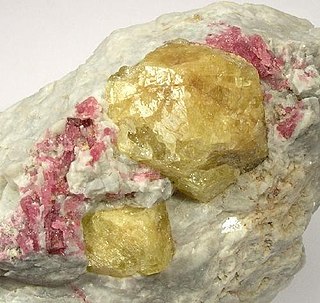
The Borate Minerals are minerals which contain a borate anion group. The borate (BO3) units may be polymerised similar to the SiO4 unit of the silicate mineral class. This results in B2O5, B3O6, B2O4 anions as well as more complex structures which include hydroxide or halogen anions. The [B(O,OH)4]− anion exists as well.

Phosphate minerals are minerals that contain the tetrahedrally coordinated phosphate anion, sometimes with arsenate and vanadate substitutions, along with chloride (Cl−), fluoride (F−), and hydroxide (OH−) anions, that also fit into the crystal structure.
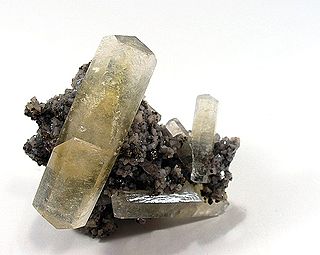
Carbonate minerals are those minerals containing the carbonate ion, CO2−
3.

Sulfosalt minerals are sulfide minerals with the general formula AmBnXp, where
Arsenate minerals usually refer to the naturally occurring orthoarsenates, possessing the (AsO4)3− anion group and, more rarely, other arsenates with anions like AsO3(OH)2− (also written HAsO42−) (example: pharmacolite Ca(AsO3OH).2H2O) or (very rarely) [AsO2(OH)2]− (example: andyrobertsite). Arsenite minerals are much less common. Both the Dana and the Strunz mineral classifications place the arsenates in with the phosphate minerals.
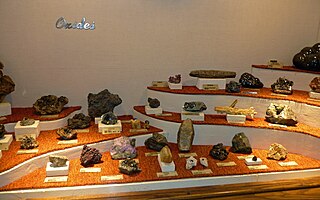
The oxide mineral class includes those minerals in which the oxide anion (O2−) is bonded to one or more metal alloys. The hydroxide-bearing minerals are typically included in the oxide class. Minerals with complex anion groups such as the silicates, sulfates, carbonates and phosphates are classed separately.

Nickel–Strunz classification is a scheme for categorizing minerals based upon their chemical composition, introduced by German mineralogist Karl Hugo Strunz in his Mineralogische Tabellen (1941). The 4th and the 5th edition was also edited by Christel Tennyson (1966). It was followed by A.S. Povarennykh with a modified classification.
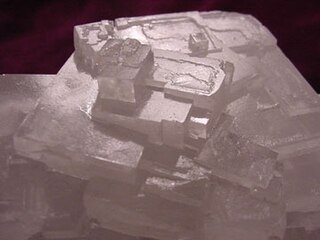
Halide minerals are those minerals with a dominant halide anion. Complex halide minerals may also have polyatomic anions.
Arsenite minerals are very rare oxygen-bearing arsenic minerals. Classical world localities where such minerals occur include the complex skarn manganese deposit at Långban (Sweden) and the polymetallic Tsumeb deposit (Namibia). The most often reported arsenite anion in minerals is the AsO33− anion, present for example in reinerite Zn3(AsO3)2. Unique diarsenite anions occur i. e. in leiteite Zn[As2O4] and paulmooreite Pb[As2O5]. More complex arsenites include schneiderhöhnite Fe2+Fe3+3[As5O13] and ludlockite PbFe3+4As10O22.

The sulfate minerals are a class of minerals that include the sulfate ion within their structure. The sulfate minerals occur commonly in primary evaporite depositional environments, as gangue minerals in hydrothermal veins and as secondary minerals in the oxidizing zone of sulfide mineral deposits. The chromate and manganate minerals have a similar structure and are often included with the sulfates in mineral classification systems.

Native element minerals are those elements that occur in nature in uncombined form with a distinct mineral structure. The elemental class includes metals, intermetallic compounds, alloys, metalloids, and nonmetals. The Nickel–Strunz classification system also includes the naturally occurring phosphides, silicides, nitrides, carbides, and arsenides.
Georgius Agricola is considered the 'father of mineralogy'. Nicolas Steno founded the stratigraphy, the geology characterizes the rocks in each layer and the mineralogy characterizes the minerals in each rock. The chemical elements were discovered in identified minerals and with the help of the identified elements the mineral crystal structure could be described. One milestone was the discovery of the geometrical law of crystallization by René Just Haüy, a further development of the work by Nicolas Steno and Jean-Baptiste L. Romé de l'Isle. Important contributions came from some Saxon "Bergraths"/ Freiberg Mining Academy: Johann F. Henckel, Abraham Gottlob Werner and his students. Other milestones were the notion that metals are elements too and the periodic table of the elements by Dmitri Ivanovich Mendeleev. The overview of the organic bonds by Kekulé was necessary to understand the silicates, first refinements described by Bragg and Machatschki; and it was only possibly to understand a crystal structure with Dalton's atomic theory, the notion of atomic orbital and Goldschmidt's explanations. Specific gravity, streak and X-ray powder diffraction are quite specific for a Nickel-Strunz identifier. Nowadays, non-destructive electron microprobe analysis is used to get the empirical formula of a mineral. Finally, the International Zeolite Association (IZA) took care of the zeolite frameworks.
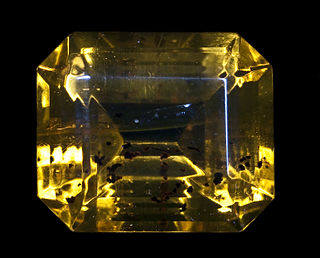
An organic mineral is an organic compound in mineral form. An organic compound is any compound containing carbon, aside from some simple ones discovered before 1828. There are three classes of organic mineral: hydrocarbons, salts of organic acids, and miscellaneous. Organic minerals are rare, and tend to have specialized settings such as fossilized cacti and bat guano. Mineralogists have used statistical models to predict that there are more undiscovered organic mineral species than known ones.
Uramphite is a rarely-found phosphate mineral in the "phosphate, arsenate and vanadate" mineral class with chemical composition (NH4)2[UO2PO4]2·6H2O from which it is seen to be a hydrated ammonium uranyl phosphate.